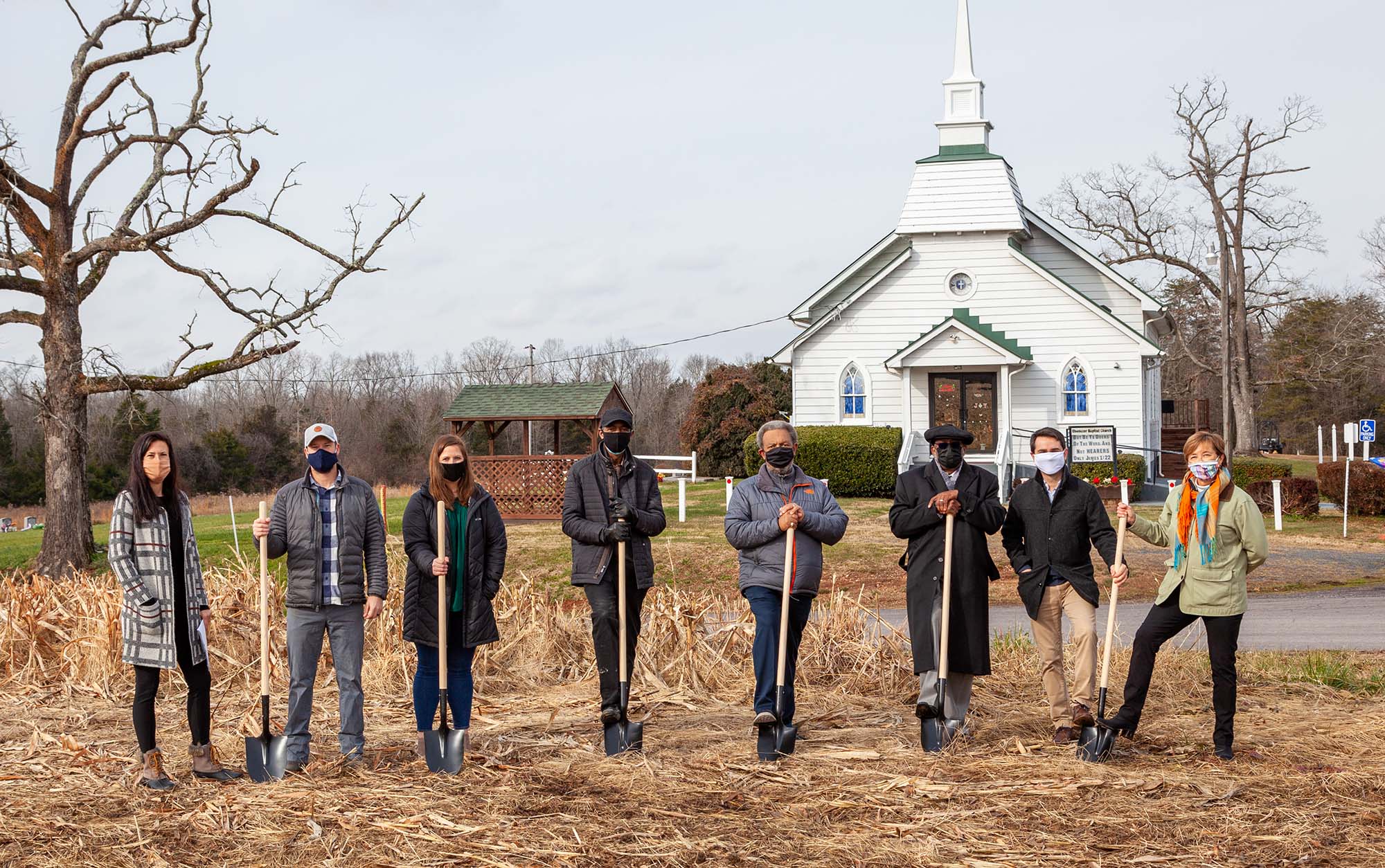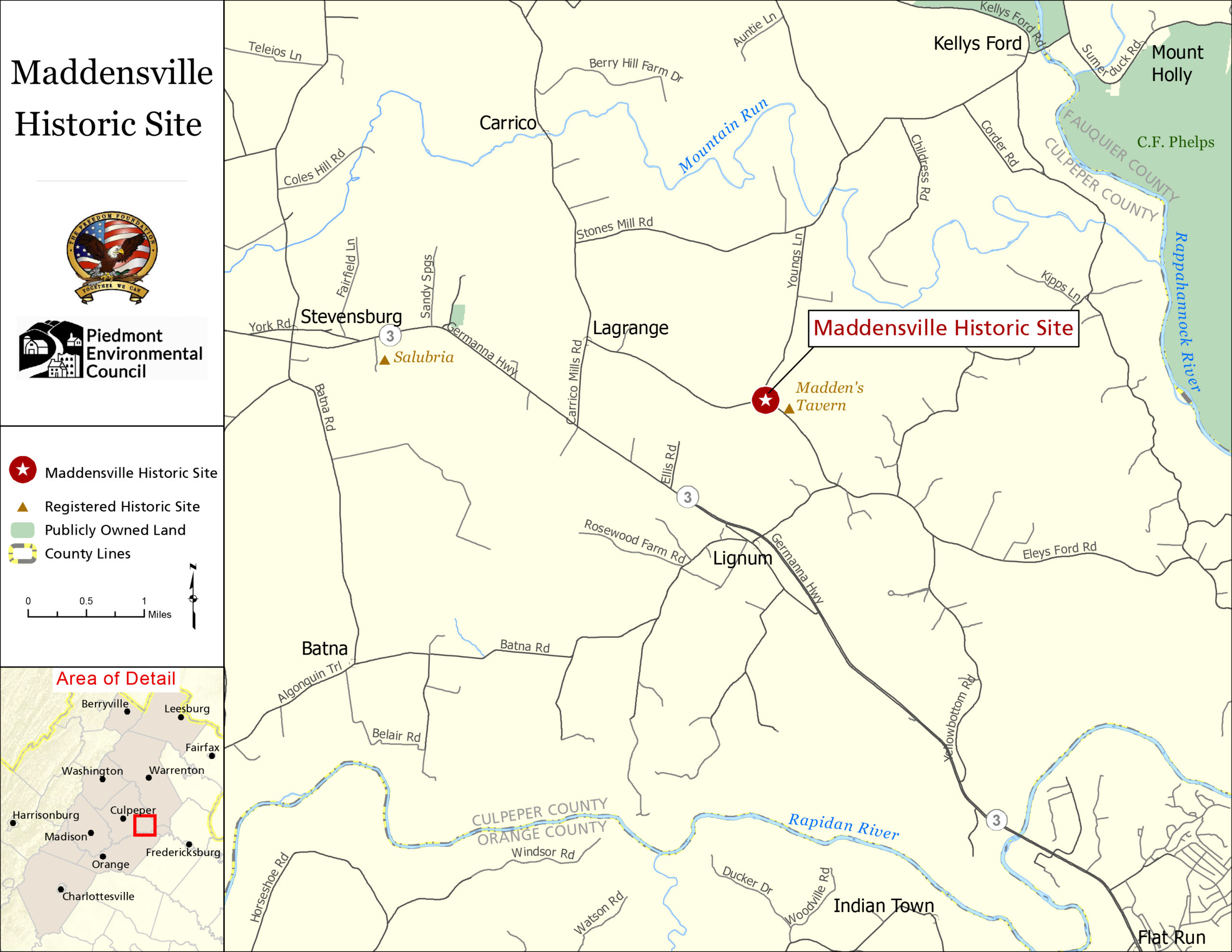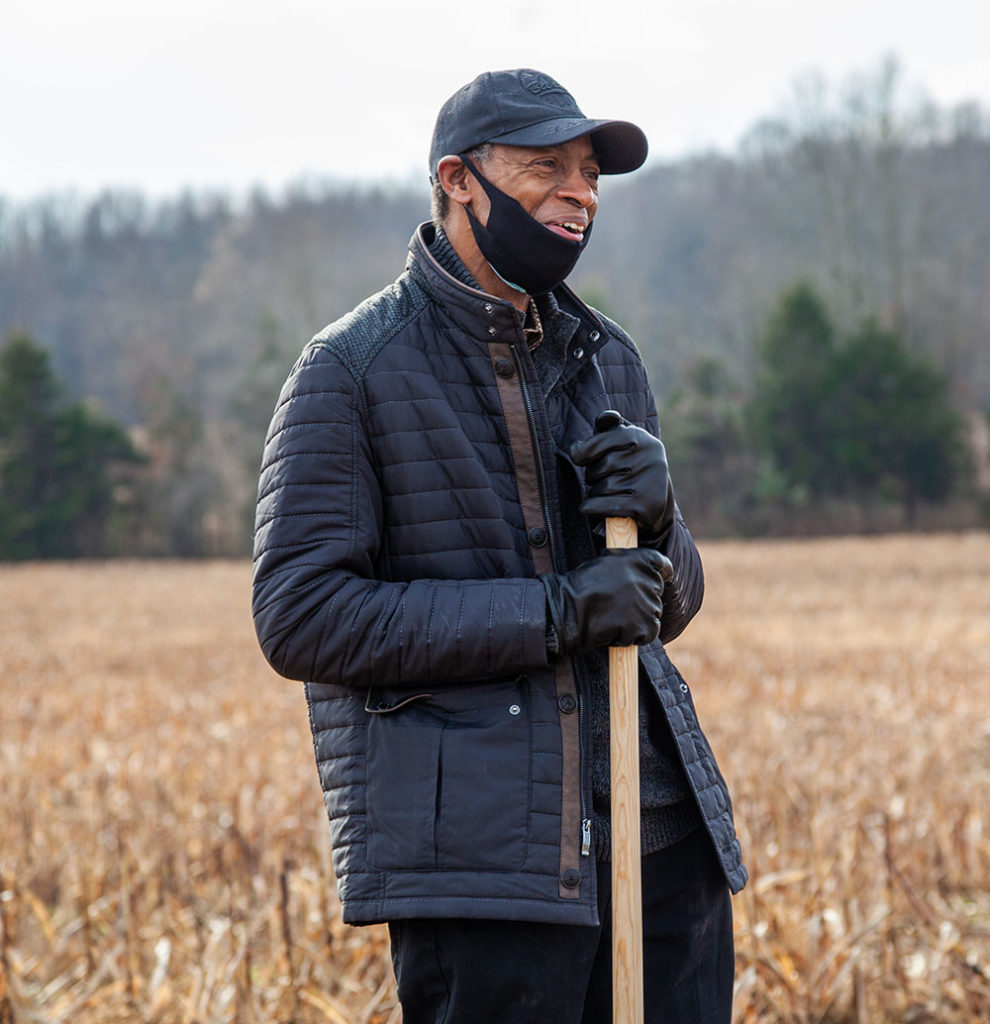
Contacts:
Howard Lambert, President, The Freedom Foundation Virginia
howstory@aol.com; 571-251-4842;
Adam Gillenwater, Culpeper County Field Representative, The Piedmont Environmental Council
agillenwater@pecva.org; 540-347-2334, x7045
LIGNUM, VA. (Oct. 29, 2021) – While a national reckoning with the impacts of long-standing Confederate symbolism has brought about the sweeping removal of many Civil War statues across the commonwealth, at 11:30 a.m. on Saturday, Nov. 6, just ahead of Veteran’s Day, a new Civil War monument will rise up in Culpeper County, Virginia. Along Madden’s Tavern Road near the once-booming crossroads of Routes 610 and 724, this granite obelisk will memorialize the ultimate sacrifice of three veterans, United States Colored Troops (USCT) who were captured and executed by 9th Virginia Cavalry troops just 300 yards away on May 8, 1864.
“We don’t know their identities, nor do we know precisely where they’re buried, but we know what happened and that they lay nearby. This is dedicated to those men, who made the ultimate sacrifice. This will be the first site dedicated to United States Colored Troops (USCT) in Culpeper County, arguably the most fought-over county during the entire Civil War,” said Howard Lambert, founder and president of The Freedom Foundation of Virginia, and for whom this memorial is a years-long labor of love.
Lambert describes Culpeper County as a kind of ground zero in the story of the United States Colored Troops, as many who were formerly enslaved went north and returned to the place of their enslavement to fight for the Union cause. “They could have stayed free and enjoyed all the privileges thereof, but these men decided to join the Union army and come back as proud soldiers in blue to fight to free people who were still in bondage, knowing that if they were captured, they would be given no quarter, but would be lined up and shot, which is obviously what happened here near Madden’s Tavern,” he said.
At least two USCT descendants will be in attendance at the Nov. 6 ceremony, including Sandra Williams, who is flying in from Florida, and Brandy Station resident Eugene Triplett, of The Freedom Foundation. Williams and Triplett connected when ancestry research revealed they are third cousins. Triplett’s great-great-grandfather, French Menefee, Sr., was a member of the 27th USCT, part of the 4th Division 9th Corps that joined the Army of the Potomac and marched at this location in Culpeper.
“When he mustered out of the 27th, he went to Ohio, got married, and died not long after. His widow applied for a tombstone from the government at the time, and that’s how we discovered him,” said Triplett. “I grew up in this area, and I’ve known the Maddens and Maddensville well all of my life, but I never knew the historical significance. It gives me a better appreciation for this area, knowing that I had relatives who traveled through here and who fought here. It makes me proud.”
Named the “Maddensville Historic Site,” this monument and memorial site is the culmination of a years-long effort by The Freedom Foundation of Virginia, in partnership with Civil War Trails and The Piedmont Environmental Council, In addition to the monument honoring the three soldiers lost here, the Maddensville Historic Site will include three Civil War Trail markers: one honoring the service and sacrifice of USCTs and the other two honoring the historic Madden’s Tavern and Ebenezer Baptist Church, both established by a free Black man, Willis Madden.

Madden’s Tavern, with its associated general store, blacksmith, and wheelwright shop, served as a popular business and rest stop frequented by travelers, teamsters, and both Union and Confederate soldiers during the Civil War. Constructed in 1840, the story-and-a-half log structure was designed, built and operated by Willis Madden, whose mother, Sarah, had been indentured for 30 years in the household of future president James Madison, before using her skills as a seamstress and laundress to help Willis purchase their first 87 acres of land.
Willis Madden rose from poverty to become the respected proprietor of what is the only known Black-owned-and-operated tavern in the Virginia Piedmont prior to the Civil War. The tavern’s success allowed the Maddens to eventually acquire hundreds of acres, which they farmed extensively, giving the area the historic moniker of Maddensville, and to donate the land and building materials to help establish Ebenezer Baptist Church and an extensive African American cemetery across the road.
Willis Madden’s great-great-granddaughter, Thomasene Madden Tarasuk, grew up in the Madden’s Tavern homestead. Though she now lives in Toronto and hasn’t been able to return to Culpeper since the Covid pandemic, she likens the strength of Sarah Madden to that of the troops who fought here. “I have great admiration for a woman of limited resources, but obviously not limited in fortitude and stamina, that she was able to plan for the future of her children and provide for the community of Maddensville, the church, and the community that evolved from that. Like her, the martyrs who sacrificed their lives there at Maddensville perhaps couldn’t phrase their motives as eloquently as Lincoln did, but they knew that they were fighting for a greater good—a better existence—for themselves and the Negroes who would come in future generations,” she said.
Quoting Sir Isaac Newton, Tarasuk added, “we all stand on the shoulders of giants.” She notes that Willis Madden’s father-in-law served in the Culpeper Minutemen of 1776. Tarasuk’s brother, Bill Madden, who will be present on November 6 to help unveil the monument and markers, was among the last group of soldiers drafted for Vietnam; he served in the Army briefly in Germany.
Lambert chose this location, Maddensville, to honor the USCT with great intention, calling it “arguably one of the most intriguing, if not historical locations in Culpeper County, not just for the obvious reasons that colored troops were killed here. It’s a physical intersection, yes, but it is also an intersection of culture and way of life.”
“Because what we have here is pre-Civil War with Madden’s Tavern in 1852, and we’ve got 1863 and 1864 when colored troops were allowed to join the union army and they came down this road by the thousands with the 4th Division 9th Corps toward the Battle of the Wilderness and then on to the Battle of the Crater, and then we’ve got post-Civil War, the church—by virtue of the Civil War people of color were allowed to practice our religion as we wanted to. Indeed, the Madden family shaped this portion of Culpeper County, so to be able to put a historical site here, the Maddensville Historic Site, is very, very special. It is the physical coming together of all three, and another thing that makes it special is that if you look around here, not much has changed on the lands from that time,” Lambert said.

Though troop raids destroyed the original outbuildings and dealt the Madden’s Tavern business a fatal blow, the building remained in the Madden family as a private home until 2017. It still stands today as “a rare relic of pre-Civil War Black entrepreneurship in rural Virginia” and is included in the Virginia Landmarks Register and National Register of Historic Places. In 2001, the tavern building and 199.5 acres of surrounding farmland were permanently conserved with a conservation easement in partnership with the Virginia Outdoors Foundation and the Virginia Department of Historical Resources. The current landowners, the Tingler and Hawkins families, have graciously provided access for the Maddenville Historic Site.
The Piedmont Environmental Council provided funding and support to help Lambert bring his vision to fruition, moving the project successfully through various county and government permitting and approval processes and raising $25,000 for the interpretive signage, obelisk, landscaping and site development. “As part of our conservation mission, PEC has always worked with landowners to preserve historic landscapes throughout the northern Piedmont. In recent years, that work has additionally emphasized documenting the untold and under told stories of the region’s African American communities and contributions,” said PEC President Chris Miller. “Civil War history is almost exclusively focused on white history, and these markers are a tremendous opportunity to tell a more complete story and to forever memorialize the contributions and sacrifice of these soldiers and their families and community,” Miller said.
Civil War Trails, Inc. has verified the accuracy of the historical accounts of this site and have helped the Freedom Foundation navigate the process of obtaining the three Civil War Trail markers. “The Freedom Foundation’s project not only lifts up this story, finally recognizing it on the landscape and reinserting back into the historic narrative, but also reminds communities around the nation that they too can bring their own stories to the forefront,” said Civil War Trails Executive Director Drew Gruber.
With the Wilderness, Chancellorsville, and Mine Run battlefields to the east, and Cedar Mountain and Brandy Station battlefield to the west, this Maddensville educational area highlighting the significant African American history associated with the Culpeper County landscape and the Civil War era will be centrally located and convenient for visitors traveling among related historic sites.
“I don’t think you can fully understand and comprehend the story of the Civil War without looking at the contributions of the more than 200,000 United States Colored Troops who fought for the Union army. And you can’t, in my view, tell a full story of Culpeper County without telling the story of the United States Colored Troops, the men who left and came back, the men who made the ultimate sacrifice. And you’ve got to tell that story because it’s intricate to how the country eventually turned out. It’s truly a labor of love for me, to come back to my hometown and focus on what happened here in Culpeper County because it’s very special and near and dear to me because it’s part of my growing up and I feel the need to share with other people so they have a greater appreciation for the sacrifices of all people during the Civil War,” Lambert said.
The Nov. 6 dedication ceremony, located at 23144 Madden’s Tavern Rd., Lignum, Va., will include short presentations by Lambert, Miller, and Civil War historian and author John Hennessy, who recently retired from his position as chief historian for the National Park Service and the Fredericksburg and Spotsylvania Military Park. Presentations will be bookended by an invocation and benediction delivered by Reverend Hashmel Turner, of the 23rd United States Colored Troops, singing of the Battle Hymn of the Republic, laying of wreaths, 21-gun salute, recognition of veterans present, and playing of Taps. Parking for the ceremony will be at Ebenezer Baptist Church. A catered reception at nearby Hazel Lake Park, the namesake of Thomasene, Bill, and their brother Thomas Madden’s mother, will follow the ceremony.
A footnote from Thomasene Madden Tarasuk: “It certainly is uncanny that on November 6, almost 158 years to the day, this project is keeping the promise to Maddensville’s group of fallen soldiers, which President Lincoln made at Gettysburg on November 19, 1863 to those buried there—that ‘their sacrifice would not be forgotten.’”
Photo, Video, Maps:
- Maps showing the Maddensville Historic Site; credit Watsun Randolph, Piedmont Environmental Council
- Ebenezer Baptist Church; photo credit Hugh Kenny, Piedmont Environmental Council
- Images from the Maddensville Historical Site groundbreaking, February 2021; photo credit Hugh Kenny, Piedmont Environmental Council
- Video of the Maddensville Historical Site groundbreaking, February 2021
#####
The Freedom Foundation was founded in 2019 and is dedicated to recognizing the contributions and legacy of Culpeper born U.S. Colored Troops. To promote for the benefit of the general public, the history, contributions and legacy of Culpeper County, Virginia born United States Colored Troops (USCTs) as well as residents of Culpeper during the American Civil War who contributed to securing freedom for its enslaved people. The primary focus shall be Culpeper born residents, however the stories and sacrifices of all Colored soldiers and their officers during the American Civil War shall also be told through advocacy and education.
Civil War Trails has been working with communities since 1994 to share their stories and connect visitors with small towns and big stories across a network that spans six states. Travelers look to Trails to put them in the footsteps of the generals, soldiers, citizens, and the enslaved who found themselves in the midst of the Civil War. Today, the program guides visitors to more than 1,200 sites, over y00 of which have become accessible to the public for the first time.
Since 1972, The Piedmont Environmental Council has proudly promoted and protected the natural resources, rural economy, history and beauty of the Virginia Piedmont. PEC empowers residents to protect what makes the Piedmont a wonderful place, and works with citizens to conserve land, improve air and water quality and build thriving communities. PEC is a 501(c)(3) non-profit and accredited land trust. Learn more at www.pecva.org.
